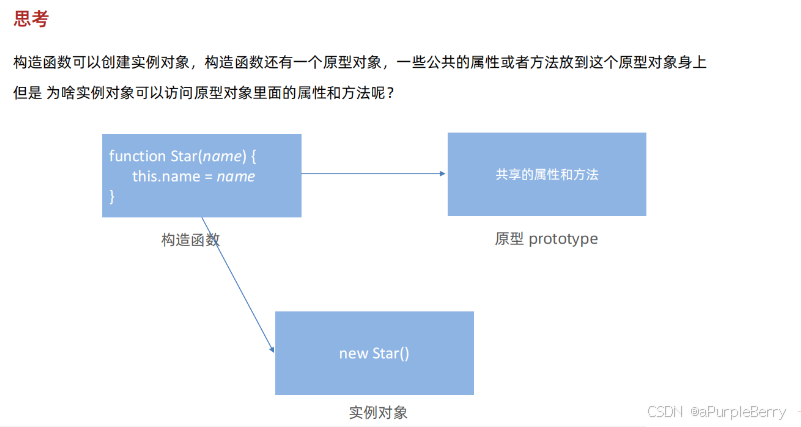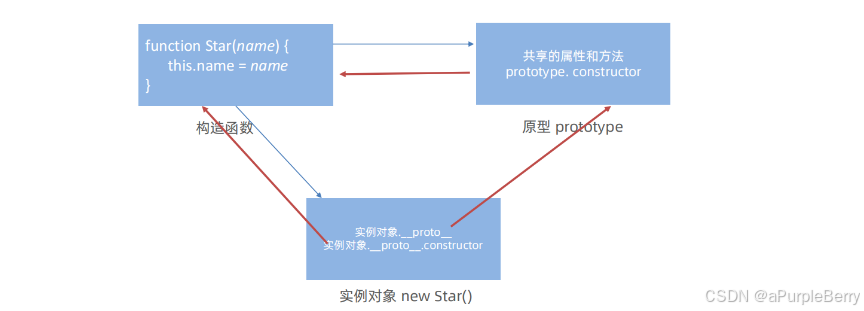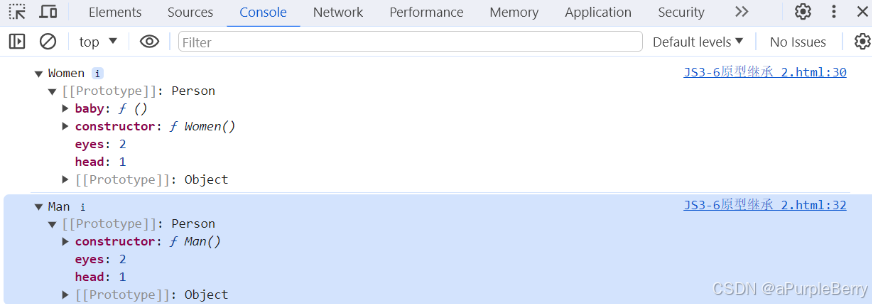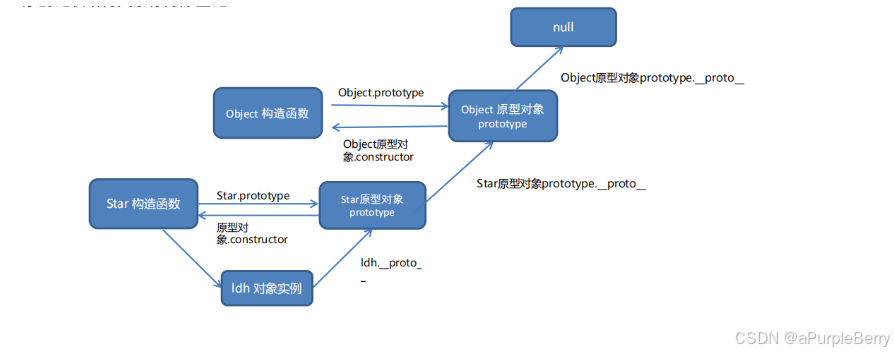构造函数
封装是面向对象思想中比较重要的一部分,js 面向对象可以通过构造函数实现的封装。
- 同样的将变量和函数组合到了一起并能通过 this 实现数据的共享,所不同的是 JS 借助构造函数创建出来的实例对象之间是彼此不影响的

- 存在浪费内存的问题,我们希望所有的对象使用同一个函数,这样就比较节省内存,那么我们要怎样做呢?

原型
1、prototype
目标:能够利用原型对象实现方法共享
构造函数通过原型分配的函数是所有对象所 共享的。
JavaScript 规定,每一个构造函数都有一个 prototype 属性,指向另一个对象,所以我们也称为原型对象
这个对象可以挂载函数,对象实例化不会多次创建原型上函数,节约内存
我们可以把那些不变的方法,直接定义在 prototype 对象上,这样所有对象的实例就可以共享这些方法。
构造函数和原型对象中的this 都指向 实例化的对象
注意:这里不可以使用箭头函数,因为箭头函数的this指向上一层
应用
举例【 我们可以把那些不变的方法,直接定义在 prototype 对象上】
// 我们可以把那些不变的方法,直接定义在 prototype 对象上 function Star(uname, age) { this.uname = uname this.age = age } Star.prototype.sing = function() { console.log(唱歌) } const ldh = new Star('刘德华',55) const zxy = new Star('张学友',58) console.log(ldh.sing === zxy.sing); //true 【构造函数和原型对象中的this 都指向 实例化的对象】
let that function Star(uname) { that = this this.uname = uname } let that2 Star.prototype.sing = function() { that2 = this console.log('唱歌'); } // 构造函数中的this指向实例化对象 const ldh = new Star('刘德华') console.log(that === ldh) // true // 原型对象中的this指向实例化对象 ldh.sing() console.log(that2 === ldh) // true ①:给数组扩展求最大值方法和求和方法
比如: 以前学过 const arr = [1,2,3]。arr.reverse() 结果是 [3,2,1]
扩展完毕之后:arr.sum() 返回的结果是 6
// 求最大值 Array.prototype.max = function() { return Math.max(...this) // 展开运算符 } Array.prototype.min = function() { return Math.min(...this) // 展开运算符 } Array.prototype.sum = function() { return this.reduce( (prev,item)=> prev + item,0) } const arr = new Array(1,2,3) // 数组实例化 console.log(arr); console.log(arr.max()); console.log(arr.min()); console.log(arr.sum()); 2、constructor 属性
每个原型对象 prototype 里面都有个constructor 属性(constructor 构造函数)
作用:该属性指向该原型对象的构造函数, 简单理解,就是指向我的爸爸,我是有爸爸的孩子

function Star() { } const ldh = new Star() console.log(Star.prototype.constructor === Star); // true constructor 的具体作用讲解:
// 背景需求:我们在原型中添加函数的时候,有可能需要一次性加很多个。 function Star2() { } // Star2.prototype.sing = function() { // console.log('唱歌'); // } // Star2.prototype.dance = function() { // console.log('跳舞'); // } console.log(Star2.prototype); // {constructor: ƒ} console.log(Star2.prototype.constructor); //ƒ Star2() {} // 我们想到或许可以用这种方法添加函数: Star2.prototype = { sing: function() { console.log('唱歌'); }, dance: function() { console.log('跳舞'); } } console.log(Star2.prototype); //{sing: ƒ, dance: ƒ} console.log(Star2.prototype.constructor); // ƒ Object() { [native code] } // 但是这种方式出现了问题,这样子的prototype是赋值,不是追加。 // 原型失去了原本的constructor // 解决方法是 加一条constructor: Star 重新指回去。这就是加一条constructor的用处 Star2.prototype = { constructor: Star, sing: function() { console.log('唱歌'); }, dance: function() { console.log('跳舞'); } } console.log(Star2.prototype); // {sing: ƒ, dance: ƒ} console.log(Star2.prototype.constructor); // ƒ Star2() {} 3、对象原型

对象都会有一个属性 __proto__指向构造函数的 prototype 原型对象,之所以我们对象可以使用构造函数 prototype 原型对象的属性和方法,就是因为对象有 __proto__ 原型的存在。

__proto__对象原型里面也有一个 constructor属性,指向创建该实例对象的构造函数
function Star() {} const ldh = new Star() console.log(ldh); // 当前实例对象指向哪个原型对象prototype console.log(ldh.__proto__ === Star.prototype); //true // __proto__对象原型里面也有一个 constructor属性,指向创建该实例对象的构造函数 console.log(ldh.__proto__.constructor === Star); //true 构造函数、实例对象、原型的关系
先有构造函数 function Star。用户通过 new Star,创建实例对象。构造函数 Star中 有属性:prototype原型(因为原型是一个对象,所以也叫作原型对象)。
实例对象 new Star()中:
实例对象有一个属性__proto__(对象原型)指向构造函数的 prototype属性(原型对象)。
实例对象的__proto__.constructor指回构造函数 Star。
原型对象prototype中:
constructor指回构造函数 Star。

- 练习
- prototype是什么?哪里来的?
原型(原型对象)
构造函数都自动有原型
- constructor属性在哪里?作用干啥的?
prototype原型和对象原型__proto__里面都有
都指向创建实例对象/原型的构造函数
__proto__属性在哪里?指向谁?
在实例对象里面
指向原型 prototype

4、原型继承
继承是面向对象编程的另一个特征,通过继承进一步提升代码封装的程度,JavaScript 中大多是借助原型对象实现继承的特性。
说明:
有女人构造函数Women、男人构造函数Men。
function Women() { this.eyes = 2 this.head = 1 } const red = new Women() console.log(red); function Men() { this.eyes = 2 this.head = 1 } const black = new Men() console.log(black); 因为构造函数中的属性都是一样,所以可以提取一个Person
const Person = { eyes = 2 head = 1 } function Women() {} function Man() {} Women.prototype = Person // 通过原型继承 Women.prototype.constructor = Women // 补充一个指回 Man.prototype = Person Man.prototype.constructor = Man const red = new Women() console.log(red); const black = new Man() console.log(black); 通过原型继承
现在想要给女人增加一个生孩子函数 baby
Women.prototype.baby = function { console.log('生孩子')} console.log(red); console.log(black); 结果发现男人也能生孩子。这是因为两者都继承了同一个对象Person
所以通过 Women.prototype = Person 和 Man.prototype = Person 这种继承是不合理的
所以可以通过构造函数 new对象,而不是const 生成对象
function Person() { this.eyes = 2 this.head = 1 } function Women() {} function Man() {} Women.prototype = new Person() // 通过原型继承 Women.prototype.constructor = Women // 补充一个指回 Man.prototype = new Person() Man.prototype.constructor = Man //实例验证 Women.prototype.baby = function() { console.log('baby') } const red = new Women() console.log(red); const black = new Man() console.log(black); 
5、原型链
__proto__属性的链状结构
基于原型对象的继承使得不同构造函数的原型对象关联在一起,并且这种关联的关系是一种链状的结构,我们将原型对象的链状结构关系称为原型链

- 举例说明
// function Object() { // } function Person() { } const ldh = new Person() // 构造函数Person 有prototype(原型) console.log(Person.prototype); console.log(Person.prototype.__proto__ === Object.prototype); // true //【前提】:每一个构造函数都有原型,每一个对象都有__proto_属性 // Person是我们定义的构造函数,构造函数Person 有prototype(原型) // 【Person.prototype】是一个对象,每个对象里面都有一个__PROTO__, // Person.prototype.__PROTO__指向 "构造出【Person.prototype】这个对象的构造函数 的prototype " // 有一个最大构造函数 Objct,这个构造函数构造出 Person.prototype // 因此,Person.prototype.__PROTO__指向Object 的prototype 原型对象(也就是一个对象实例),指向 构造出这个对象的构造函数(function) 的prototype 原型对象 
查找规则
__proto__对象原型的意义就在于为对象成员查找机制提供一个方向,或者说一条路线
查找规则如下:
① 当访问一个对象的属性(包括方法)时,首先查找这个对象自身有没有该属性。
② 如果没有就查找它的原型(也就是 __proto__指向的 prototype 原型对象)
③ 如果还没有就查找原型对象的原型(Object的原型对象)
④ 依此类推一直找到 Object 为止(null)
⑤ __proto__对象原型的意义就在于为对象成员查找机制提供一个方向,或者说一条路线
⑥ 可以使用 instanceof 运算符用于检测构造函数的 prototype 属性是否出现在某个实例对象的原型链上
const arr = [1,2,3] // arr是对象 相当于 const arr = new Array(1,2,3) arr.map(function() { // 略 }) 1、当访问 arr 的方法 map 时,首先查找这个对象自身有没有该属性。 发现没有 2、查找 arr 的原型(也就是 arr.__proto__指向的 prototype 原型对象) 该prototype 原型对象 属于 构造函数 Array的原型,找到了 - instance of
const zxy = new Person() console.log(zxy instanceof Person); // zxy 属于 Person 吗 : true console.log(zxy instanceof Object); // zxy 属于 Object 吗 : true console.log(zxy instanceof Array); // zxy 属于 Array 吗 : false console.log(Array instanceof Object); // true 小结 原型和原型链
1.原型:函数都有prototype属性,称之为原型,也称为原型对象
原型可以放一些属性和方法,共享给实例对象使用
原型可以做继承
2.原型链:查找一个对象的属性和方法的时候,先在自身找,找不到则沿着__proto__向上查找,我们把__proto__形成的链条关系称原型链
__proto__属性是每一个对象以及函数都有的一个属性。__proto__属性指向的是创建他的构造函数的prototype。原型链就是通过这个属性构件的。
